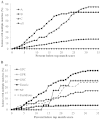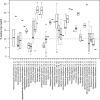Optimization of matrix-assisted laser desorption ionization-time of flight mass spectrometry analysis for bacterial identification
- PMID: 22993178
- PMCID: PMC3502975
- DOI: 10.1128/JCM.00626-12
Optimization of matrix-assisted laser desorption ionization-time of flight mass spectrometry analysis for bacterial identification
Abstract
Matrix-assisted laser desorption ionization-time of flight mass spectrometry (MALDI-TOF MS) is a relatively new addition to the clinical microbiology laboratory. The performance of the MALDI Biotyper system (Bruker Daltonics) was compared to those of phenotypic and genotypic identification methods for 690 routine and referred clinical isolates representing 102 genera and 225 unique species. We systematically compared direct-smear and extraction methods on a taxonomically diverse collection of isolates. The optimal score thresholds for bacterial identification were determined, and an approach to address multiple divergent results above these thresholds was evaluated. Analysis of identification scores revealed optimal species- and genus-level identification thresholds of 1.9 and 1.7, with 91.9% and 97.0% of isolates correctly identified to species and genus levels, respectively. Not surprisingly, routinely encountered isolates showed higher concordance than did uncommon isolates. The extraction method yielded higher scores than the direct-smear method for 78.3% of isolates. Incorrect species were reported in the top 10 results for 19.4% of isolates, and although there was no obvious cutoff to eliminate all of these ambiguities, a 10% score differential between the top match and additional species may be useful to limit the need for additional testing to reach single-species-level identifications.
Figures



Similar articles
-
Ongoing revolution in bacteriology: routine identification of bacteria by matrix-assisted laser desorption ionization time-of-flight mass spectrometry.Clin Infect Dis. 2009 Aug 15;49(4):543-51. doi: 10.1086/600885. Clin Infect Dis. 2009. PMID: 19583519
-
Identification of rare pathogenic bacteria in a clinical microbiology laboratory: impact of matrix-assisted laser desorption ionization-time of flight mass spectrometry.J Clin Microbiol. 2013 Jul;51(7):2182-94. doi: 10.1128/JCM.00492-13. Epub 2013 May 1. J Clin Microbiol. 2013. PMID: 23637301 Free PMC article.
-
Performances of the Vitek MS matrix-assisted laser desorption ionization-time of flight mass spectrometry system for rapid identification of bacteria in routine clinical microbiology.J Clin Microbiol. 2012 Aug;50(8):2568-76. doi: 10.1128/JCM.00343-12. Epub 2012 May 16. J Clin Microbiol. 2012. PMID: 22593596 Free PMC article.
-
Matrix-assisted laser desorption/ionization time-of-flight mass spectrometry: a new possibility for the identification and typing of anaerobic bacteria.Future Microbiol. 2014;9(2):217-33. doi: 10.2217/fmb.13.150. Future Microbiol. 2014. PMID: 24571074 Review.
-
Use of MALDI-TOF mass spectrometry for identification of bacteria that are difficult to culture.J Microbiol Methods. 2013 Jan;92(1):14-24. doi: 10.1016/j.mimet.2012.10.014. Epub 2012 Nov 12. J Microbiol Methods. 2013. PMID: 23154044 Review.
Cited by
-
Detection of non-jejuni and -coli Campylobacter species from stool specimens with an immunochromatographic antigen detection assay.J Clin Microbiol. 2013 Jun;51(6):1935-7. doi: 10.1128/JCM.03208-12. Epub 2013 Apr 3. J Clin Microbiol. 2013. PMID: 23554192 Free PMC article.
-
The effect of α1-antitrypsin deficiency combined with increased bacterial loads on chronic obstructive pulmonary disease pharmacotherapy: A prospective, parallel, controlled pilot study.J Adv Res. 2016 Nov;7(6):1019-1028. doi: 10.1016/j.jare.2016.05.002. Epub 2016 May 11. J Adv Res. 2016. PMID: 27857848 Free PMC article.
-
Compatibility of Maximum-Containment Virus-Inactivation Protocols With Identification of Bacterial Coinfections by Matrix-Assisted Laser Desorption/Ionization Time-of-Flight Mass Spectrometry.J Infect Dis. 2018 Nov 22;218(suppl_5):S297-S300. doi: 10.1093/infdis/jiy292. J Infect Dis. 2018. PMID: 29982557 Free PMC article.
-
MALDI-TOF MS Biomarker Detection Models to Distinguish RTX Toxin Phenotypes of Moraxella bovoculi Strains Are Enhanced Using Calcium Chloride Supplemented Agar.Front Cell Infect Microbiol. 2021 Mar 16;11:632647. doi: 10.3389/fcimb.2021.632647. eCollection 2021. Front Cell Infect Microbiol. 2021. PMID: 33796479 Free PMC article.
-
Comparison of the accuracy of matrix-assisted laser desorption ionization-time of flight mass spectrometry with that of other commercial identification systems for identifying Staphylococcus saprophyticus in urine.J Clin Microbiol. 2013 May;51(5):1563-6. doi: 10.1128/JCM.00261-13. Epub 2013 Feb 6. J Clin Microbiol. 2013. PMID: 23390286 Free PMC article.
References
-
- Alatoom AA, Cunningham SA, Ihde SM, Mandrekar J, Patel R. 2011. Comparison of direct colony method versus extraction method for identification of Gram-positive cocci by use of Bruker Biotyper matrix-assisted laser desorption ionization–time of flight mass spectrometry. J. Clin. Microbiol. 49:2868–2873 - PMC - PubMed
-
- Benagli C, Rossi V, Dolina M, Tonolla M, Petrini O. 2011. Matrix-assisted laser desorption ionization-time of flight mass spectrometry for the identification of clinically relevant bacteria. PLoS One 6:e16424 doi:10.1371/journal.pone.0016424 - DOI - PMC - PubMed
Publication types
MeSH terms
LinkOut - more resources
Full Text Sources

